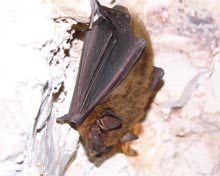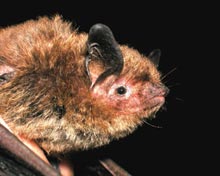
Tom Murray, Illinois Department of Natural Resources

U.S. Public Health Service courtesy of Internet Center for Wildlife Damage Management
Bats
General Description
Species most commonly found in structures include the little brown bat (Myotis lucifugus) and big brown bat
(Eptesicus fuscus). These species have a wingspan of less than 12 inches and weigh one-half of an ounce or
less. Midwestern bats feed exclusively on insects, consuming many pest species such as night-flying moths.
Though considered beneficial animals, bats can pose a threat to human health. Histoplasmosis (a disease
associated with bat guano and bird droppings) and rabies are the most important diseases associated with bats
in the Midwest. Rabid bats may exhibit no obvious abnormalities, so all contact with bats should be avoided.
People should NOT be allowed to occupy a room in which bats are found, until it is certain that no bats remain in
the room and it has been sealed to prevent their re-entry. Of less importance are bat parasites. Fleas, lice, mites
and bat bugs infest bats, birds and other animals, and occasionally attack humans.
General Control
It is unlawful to harm or kill a bat. Only under special circumstances are permits to kill bats granted by the Illinois
Department of Natural Resources. Exclusion remains the best way to prevent and control bats in a structure. Bats
can be excluded by sealing exterior openings larger than one-half of an inch, using expandable foam, plywood,
mortar, metal flashing, steel wool or one-fourth of an inch mesh screen or netting. Make sure doors, windows and
vents have screens and are securely framed; chimneys are capped; and gaps around utility lines are plugged.
Although exclusion is the best way to rid structures of bats, knowledge and timing are critical for effective batproofing
and to avoid trapping bats indoors. Especially in older construction, there may be several bat entry
points that can be difficult to discover. For these reasons, bat exclusion may be best left to professionals.









